The 1965 Buick Skylark, a symbol of American automotive prowess, marked a pivotal year for Buick, introducing a fresh design language and performance enhancements that captivated drivers. Released amidst the burgeoning muscle car era, the Skylark offered a compelling blend of style and power, reflecting the cultural zeitgeist of the time.
Its sleek lines, powerful engine options, and innovative features cemented its place as a beloved classic.
The Skylark’s introduction coincided with a period of significant social and economic change, with Americans embracing a sense of optimism and a growing desire for personal freedom. The car’s design, performance, and features perfectly encapsulated these aspirations, becoming a symbol of the American dream.
The 1965 Buick Skylark: A Classic Resurgence
The 1965 Buick Skylark marked a significant turning point for the model, representing a departure from its earlier compact roots and embracing a more muscular, sporty identity. This year saw the introduction of the Skylark Gran Sport, a performance-oriented trim level that quickly became a favorite among enthusiasts.
This transition reflected the broader cultural shifts of the mid-1960s, where a growing appetite for performance and style was reshaping the American automotive landscape.
Cultural Context and Automotive Trends
The 1965 Buick Skylark’s release coincided with a period of significant economic growth and cultural change in the United States. The postwar boom had created a generation of consumers with disposable income, leading to a surge in demand for automobiles.
This demand fueled a competitive market where manufacturers focused on innovation, performance, and style to capture the attention of buyers. The Skylark’s design, with its sharp lines, prominent grille, and optional performance upgrades, embodied this spirit of the era.
The Skylark Gran Sport: A Performance Icon
The Skylark Gran Sport, introduced in 1965, represented Buick’s commitment to performance and a direct response to the growing popularity of muscle cars. It featured a powerful 401 cubic-inch V8 engine, a distinctive hood scoop, and performance-oriented suspension components. The Gran Sport quickly gained a reputation for its impressive acceleration and handling, establishing itself as a formidable contender in the burgeoning muscle car market.
Design and Styling
The 1965 Skylark showcased a redesigned body style that was both stylish and aerodynamic. It featured a long, sweeping hood, a prominent grille with vertical chrome bars, and a distinctive rear end with taillights that extended into the rear fenders.
The interior featured comfortable seating, woodgrain accents, and a range of optional features that reflected the luxurious nature of Buick vehicles.
Design and Styling
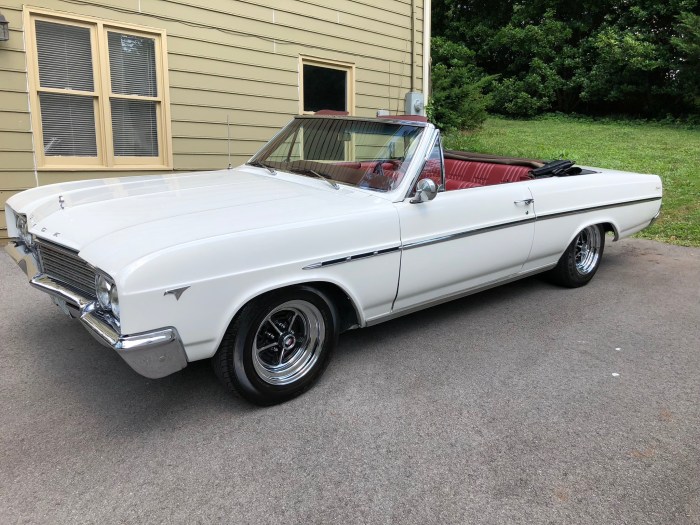
The 1965 Buick Skylark, a product of General Motors’ design prowess, embodied the spirit of the mid-1960s with its distinctive styling and sophisticated features. It showcased a blend of classic Buick design elements with contemporary trends, creating a car that was both elegant and sporty.
The 1965 Buick Skylark, a mid-size muscle car, was a popular choice for its sleek styling and powerful engine. While the ’65 model was a standout, the next generation, the 1967 Buick Skylark , took things to another level with a completely redesigned body and a wider range of engine options.
This model helped solidify the Skylark’s reputation as a performance-oriented car, making it a sought-after classic today.
Exterior Design
The Skylark’s exterior design was characterized by its long, flowing lines and a prominent grille that featured Buick’s signature “porthole” design. The car’s profile was highlighted by a low roofline, sweeping fenders, and a graceful, sculpted hood. The Skylark was available in a variety of colors, including several two-tone combinations, allowing buyers to personalize their vehicles.
The 1965 Buick Skylark, with its sleek lines and powerful engine, represented a shift in design philosophy for the brand. This was a far cry from the more conservative styling of its predecessors, like the 1953 Buick Special , which was known for its chrome-laden grille and wide, flowing fenders.
The Skylark, however, embraced a more modern aesthetic, showcasing a sportier stance and a focus on performance, paving the way for a new era of Buick automobiles.
Interior Design
Inside, the Skylark offered a comfortable and luxurious environment. The interior featured plush upholstery, woodgrain accents, and a well-appointed dashboard. The seats were designed for comfort and provided ample legroom and headroom. The instrument panel was clear and easy to read, and the controls were within easy reach.
The Skylark’s interior was a testament to Buick’s commitment to providing a premium driving experience.
Styling Comparison, 1965 Buick Skylark
The Skylark’s styling was distinct from other cars of the era. While many cars of the 1960s were characterized by sharp angles and aggressive lines, the Skylark maintained a more refined and elegant aesthetic. The Skylark’s styling was more in line with other luxury cars of the time, such as the Cadillac Eldorado and the Lincoln Continental.
Performance and Handling
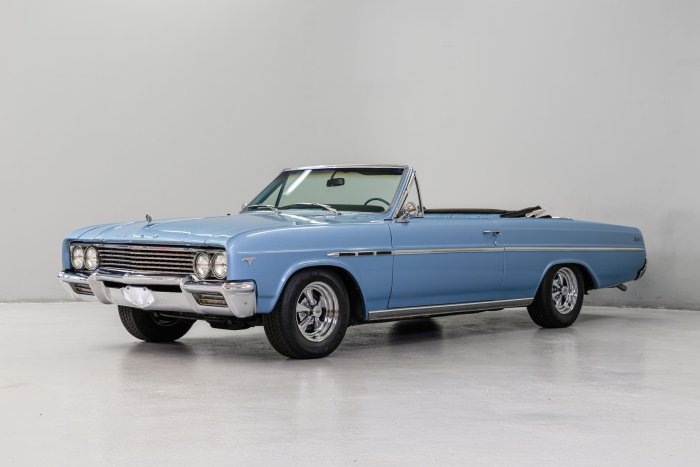
The 1965 Buick Skylark, while known for its stylish design, also offered a respectable level of performance and handling for its time. Buick equipped the Skylark with a range of engine options and transmission choices, catering to a variety of driving preferences.
The 1965 Buick Skylark was a popular choice for its stylish design and powerful engine. While the ’65 model was a hit, Buick continued to refine its offerings, and the following year saw the introduction of the 1966 Buick Skylark.
This model brought subtle updates to the design, including a revised grille and taillights. While the ’66 Skylark retained the same essence of its predecessor, it offered a slightly more modern look, solidifying its place as a sought-after classic car.
The car’s handling was generally considered competent for its era, although it wasn’t as sporty as some of its contemporaries.
Engine Options
The 1965 Skylark was available with a selection of engines, each offering a distinct performance profile.
- The standard engine was a 215 cubic inch (3.5L) V6, producing 155 horsepower.This engine provided adequate power for everyday driving, but it wasn’t particularly exciting.
- A 300 cubic inch (4.9L) V8 was also available, generating 190 horsepower.This engine offered a noticeable improvement in performance over the V6, making the Skylark a more spirited car to drive.
- For those seeking more power, a 340 cubic inch (5.6L) V8 with 250 horsepower was available.This engine provided the most potent performance option for the Skylark, allowing for quicker acceleration and a more exhilarating driving experience.
Transmission Choices
The 1965 Skylark was offered with a choice of two transmissions:
- A three-speed manual transmissionwas standard equipment on the Skylark, providing a direct and engaging driving experience.
- A two-speed automatic transmissionwas optional, offering convenience and ease of driving, especially in urban environments. This transmission, however, sacrificed some of the performance and responsiveness of the manual transmission.
Handling Characteristics
The 1965 Skylark’s handling was generally considered competent for its time. The car’s suspension, a combination of coil springs and shock absorbers, provided a comfortable ride and reasonable handling capabilities. However, compared to some of its sportier contemporaries, the Skylark’s handling was not as sharp or precise.
The car’s relatively soft suspension and body roll made it less than ideal for aggressive driving.
Cultural Impact: 1965 Buick Skylark
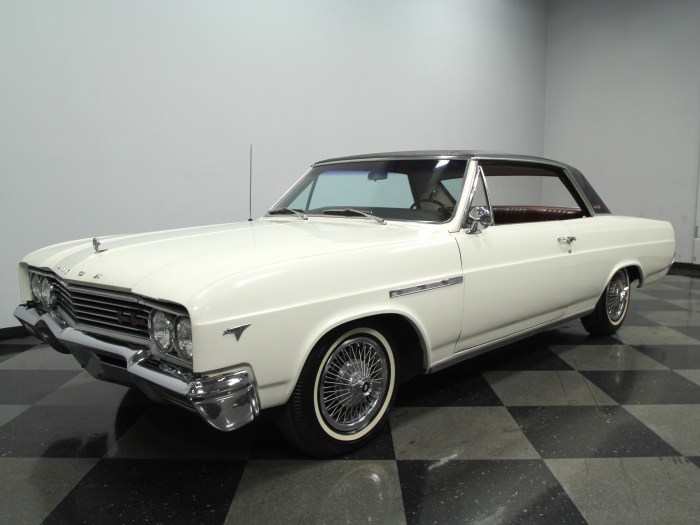
The 1965 Buick Skylark, with its sleek design and powerful engine, resonated with the spirit of the 1960s, becoming a symbol of American prosperity and optimism. Its presence in popular culture solidified its iconic status, influencing the perception of both the automobile and the era itself.
Appearances in Popular Media
The Skylark’s distinct silhouette and association with the American Dream made it a popular choice for filmmakers and television producers. Its presence in numerous films and television shows, often as a symbol of status and mobility, further cemented its place in popular culture.
- The 1965 Skylark made a memorable appearance in the 1967 film “The Graduate,”driven by the character Benjamin Braddock (Dustin Hoffman). This scene, where Braddock drives the Skylark through the streets of Los Angeles, became iconic, symbolizing the anxieties and aspirations of a generation grappling with the changing social landscape.
- In the 1970s television series “The Rockford Files,”the private investigator Jim Rockford (James Garner) drove a 1970 Buick Skylark, a vehicle that perfectly captured the character’s rugged individualism and resourceful nature. The Skylark’s appearance in the show helped to solidify its image as a reliable and dependable car, a perfect fit for a private investigator navigating the underbelly of Los Angeles.
Collecting and Restoring
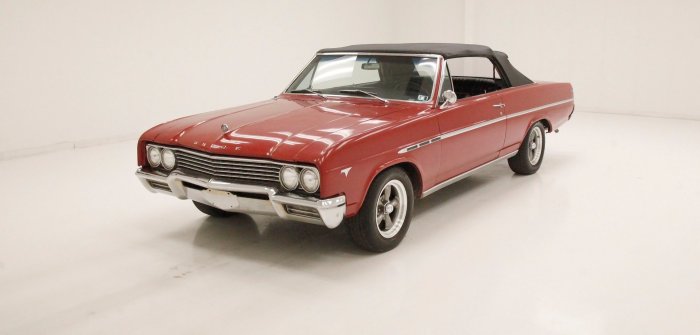
The 1965 Buick Skylark has experienced a resurgence in popularity among classic car enthusiasts, making it a sought-after collectible. The combination of its timeless design, powerful engine options, and cultural significance has contributed to its enduring appeal.
Market Value
The market value of a 1965 Buick Skylark varies significantly depending on condition, options, and mileage. A well-preserved original model with low mileage can fetch a premium price, while a restored car may command a higher value if the restoration is done to a high standard.
According to Hagerty, a 1965 Buick Skylark in excellent condition can be valued at over $20,000, while a concours-quality example could sell for upwards of $35,000.
Challenges and Rewards of Collecting and Restoring
Collecting and restoring a 1965 Buick Skylark can be a rewarding experience, but it also presents a unique set of challenges.
Challenges
- Finding a good example can be challenging, as many Skylarks have been modified or neglected over the years.
- Restoration can be a time-consuming and expensive process, requiring specialized skills and knowledge.
- Sourcing original parts can be difficult, as some parts are no longer in production.
- The restoration process can be demanding, requiring patience, dedication, and a willingness to learn.
Rewards
- The satisfaction of owning and restoring a piece of automotive history.
- The opportunity to enjoy a classic car with its unique driving experience and timeless design.
- The chance to connect with other enthusiasts and share your passion for the Skylark.
- The potential for appreciation in value, as classic cars can be a good investment.
Resources and Information
For enthusiasts interested in owning a 1965 Buick Skylark, there are numerous resources available.
Online Resources
- Buick Skylark Club of America:A dedicated organization for Skylark enthusiasts, offering technical support, parts sourcing, and events.
- Hagerty:A leading resource for classic car valuation, insurance, and information.
- eBay Motors:A popular online marketplace for buying and selling classic cars, including Skylarks.
Books and Magazines
- “The Buick Skylark: A History”by John Gunnell: A comprehensive history of the Skylark model, covering its design, production, and cultural impact.
- “Classic Car Restoration”magazine: A monthly publication featuring articles on classic car restoration, maintenance, and preservation.
Local Clubs and Events
- Local Buick Clubs:Many areas have Buick clubs that offer events, technical support, and a community of enthusiasts.
- Car Shows and Auctions:Attending car shows and auctions can be a great way to see Skylarks in person, meet other enthusiasts, and learn about the market.
Wrap-Up
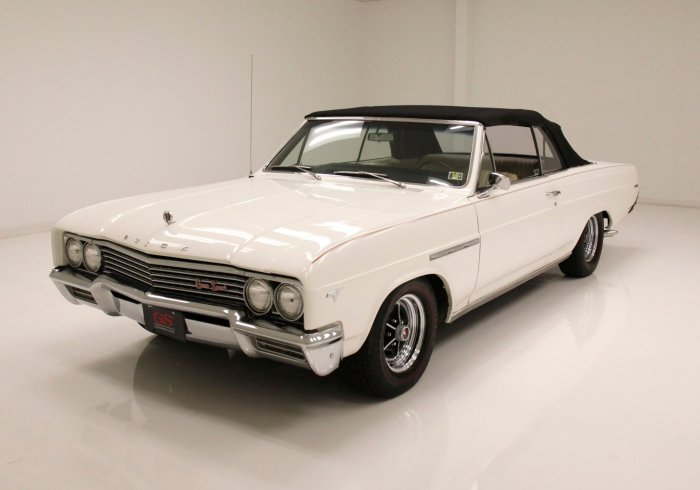
The 1965 Buick Skylark stands as a testament to the enduring legacy of American automotive ingenuity. Its timeless design, potent performance, and cultural impact have solidified its status as a classic muscle car. For enthusiasts and collectors alike, the Skylark continues to evoke a sense of nostalgia and admiration, reminding us of a bygone era of automotive excellence and cultural influence.